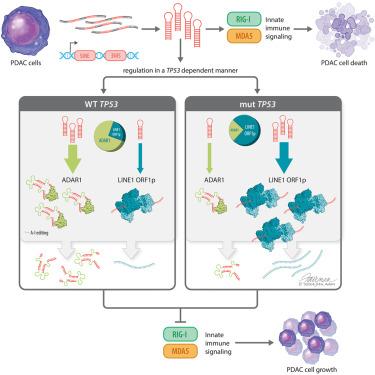癌细胞通过不同机制限制转座子表达的免疫原性
IF 25.5
1区 医学
Q1 IMMUNOLOGY
引用次数: 0
摘要
癌细胞要想茁壮成长,就必须穿越伴随致癌转化的急性炎症信号,例如通过重复元素的过度表达。我们研究了免疫刺激重复表达、肿瘤演变和肿瘤免疫微环境之间的关系。通过整合一组胰腺导管腺癌(PDAC)患者的多模态数据,我们发现了特定阿鲁重复序列的表达,这些阿鲁重复序列被预测为可形成双链RNA(dsRNA)并触发视黄酸诱导基因I(RIG-I)类受体(RLR)相关的I型干扰素(IFN)信号传导。这种源于Alu的dsRNA还与晚期肿瘤中的促肿瘤性巨噬细胞浸润有反相关性。我们定义了 PDAC 适应这种抗肿瘤信号的两种互补途径。在突变型 TP53 肿瘤中,来自长间断核元素(LINE)-1 的 ORF1p 优先结合 Alus 并降低其表达,而在野生型 TP53 肿瘤中,作用于 RNA 1 的腺苷脱氨酶(ADAR1)编辑主要减少 dsRNA 的形成。删除 LINE-1 ORF1p 或 ADAR1 都会减少肿瘤在体外的生长。肿瘤利用多种途径减轻免疫刺激重复序列的事实意味着,这些重复序列的表达所带来的压力是 PDAC 以及其他肿瘤所适应的基本现象。本文章由计算机程序翻译,如有差异,请以英文原文为准。

Cancer cells restrict immunogenicity of retrotransposon expression via distinct mechanisms
To thrive, cancer cells must navigate acute inflammatory signaling accompanying oncogenic transformation, such as via overexpression of repeat elements. We examined the relationship between immunostimulatory repeat expression, tumor evolution, and the tumor-immune microenvironment. Integration of multimodal data from a cohort of pancreatic ductal adenocarcinoma (PDAC) patients revealed expression of specific Alu repeats predicted to form double-stranded RNAs (dsRNAs) and trigger retinoic-acid-inducible gene I (RIG-I)-like-receptor (RLR)-associated type-I interferon (IFN) signaling. Such Alu-derived dsRNAs also anti-correlated with pro-tumorigenic macrophage infiltration in late stage tumors. We defined two complementary pathways whereby PDAC may adapt to such anti-tumorigenic signaling. In mutant TP53 tumors, ORF1p from long interspersed nuclear element (LINE)-1 preferentially binds Alus and decreases their expression, whereas adenosine deaminases acting on RNA 1 (ADAR1) editing primarily reduces dsRNA formation in wild-type TP53 tumors. Depletion of either LINE-1 ORF1p or ADAR1 reduced tumor growth in vitro. The fact that tumors utilize multiple pathways to mitigate immunostimulatory repeats implies the stress from their expression is a fundamental phenomenon to which PDAC, and likely other tumors, adapt.
求助全文
通过发布文献求助,成功后即可免费获取论文全文。
去求助
来源期刊

Immunity
医学-免疫学
CiteScore
49.40
自引率
2.20%
发文量
205
审稿时长
6 months
期刊介绍:
Immunity is a publication that focuses on publishing significant advancements in research related to immunology. We encourage the submission of studies that offer groundbreaking immunological discoveries, whether at the molecular, cellular, or whole organism level. Topics of interest encompass a wide range, such as cancer, infectious diseases, neuroimmunology, autoimmune diseases, allergies, mucosal immunity, metabolic diseases, and homeostasis.
 求助内容:
求助内容: 应助结果提醒方式:
应助结果提醒方式:


